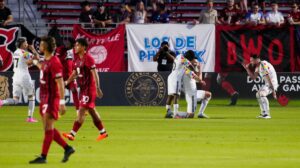(HARRISON, NJ)The New York Red Bulls have a problem. There is no denying it. Everyone at the club knows it. NY is a tremendously talented team that can pull teams apart. They frustrate their opponents with a relentless press. Teams in MLS have no choice but to drop numbers behind the ball and pick their shots to cope. To that end, the Red Bulls have put themselves in winning positions in a number of games only to surrender second half goals dropping points.
New York Red Bulls – How To Turn Three Points Into One
More specifically, and painfully, they have dropped points on four notable occasions while maintaining two-goal leads. Often described as the most dangerous lead in soccer, two goals to nil should be a comfort for team.
Instead, it is a nightmare for the 2016 Red Bulls.
There has been a lot of talk about just what is wrong with NY and why they have trouble closing out games. Just over a week ago, Ben Olsen, coach of D.C. United, sited the Red Bulls reliance on the high press as a means for allowing teams to stay in games. There is some truth to that, but it is certainly not the whole picture. The reason the New York Red Bulls are dropping points should be familiar to any longtime fan of the franchise.
History Lesson
Many fans of the team will remember the bad more than they ever will the good. It is something that comes with the territory of NY fandom. One of the worst times for Red Bulls fans was 2009. It was a year coming off of a MLS Cup Final appearance, and a highly touted coach, Juan Carlos Osorio. Osorio had been heralded as the man to turn NY’s fortunes around as he had with the Chicago Fire. Osorio effectively replaced Bruce Arena in one of the worst coaching moves in team history.
The short-term gains the team achieved in 2008 were speculative at best. The 2009 season proved what many had already known; Osorio was little more than smoke and mirrors. He was a coach who out thought himself to the detriment of the team. Week to week he changed his tactics to neutralize the opponents. This led to a team with no identity or set roles.
The Osorio Style
In 2009, that all came to a head with a massive winless streak the likes of which Metro had never seen. After a particularly bad start to the season, the Red Bulls went winless in 13 games, nearly four months. One big reason was a negative approach to the game in the second half. The epitome of this approach was a game against D.C. United before the winless streak began. The fact that D.C. was the opponent, and the approach so similar is a fun coincidence.
The Red Bulls were winning 2-1 over their rivals after 80 minutes on goals from Juan Pablo Angel and Dane Richards. In the 84th minute, Osorio inserted Juan Pietravallo to “lock up the shop”. Rather than assert their control on the game at home, the Red Bulls began to play a style I associate with Osorio. Clear the ball. Don’t try to hold possession and see out time. Send the ball up field and allow the opposing team to attack relentlessly over the final 10-15 minutes of a game. On this occasion, D.C. scored twice after the 89th minute to win the game 3-2. Eerie.
Toronto FC
Jesse Marsch and the Red Bulls struggled early this year. They suffered a crisis of confidence and were lost for most of the first 8 games of the season. Since then, they have maintained a positive record, but succumb to the same strategy, especially on the road. Toronto FC was no exception. The Red Bulls held a lead at halftime, and they fell into the shell there after. It wasn’t after the substitutions were made. It was from the start of the half. Compare these two passing maps from the first and second half of the draw at Toronto.


They played most of the second half without the ball, and deep behind the midfield stripe. It is visually striking.
DC United
For the home draw to D.C. a few weeks ago, you can see the same in the possession numbers for the game. The chart below is represented in five-minute intervals. The final 10 minutes Red Bulls hardly possessed the ball.

Red Bull forego any possession after the 90th minute. Instead they sit back and wait. To D.C.’s credit, they did pressure well over that period, but NY did little to attempt to hold the ball.
LA Galaxy
The same can be seen in the game against LA Galaxy. Particularly after they go up 2-0.


Allowing opponents to attack like this invites pressure. The chance for failure becomes greater as the number of attempts rise. You can also look at the number of chances conceded to see an alarming pattern when dropping into this negative defensive posture. Below is a chart of total shots taken in a match and shots taken after the Red Bulls go up by two goals.

This chart is very telling. The game versus LA seems low, but it is important to remember when the Red Bulls took the lead, the 75th minute. 36.4% of their shots in the game came in the final 15 minutes.
The Fix?
There is a clear issue that should be easy to solve right? Well, now we are getting into a bit of a gray area. Even in NY’s most dominant wins, they are following this game plan. In fact, they only seem to have deviated from it once all season, a 2-0 win over Seattle Sounders. MLS Analyst, Matt Doyle, even called them out for closing out the game in this manner. Seattle could not press the ball and New York strong together huge passing sequences to kill off the game. It was the Red Bull’s best performance of the season, but it evaporated. Why did they shift away from this very effective style?
There is no clear answer. While the team has been their own worst enemy, they still earned a huge number of results with their current tactics, at least at home. So why would they change what is working? They have the personnel to see out games like they did against Seattle, but they need to believe they can do it. Starting the season in a big hole like they did, forced their hand to some degree. Piling bodies into their own half to try to see out games is the “safe” way to play. The results may not agree with that assumption.






